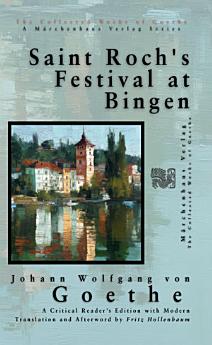Saint Rochus Festival at Bingen
About this ebook
Rather than treat the event sentimentally or critically, Goethe presents the festival as a living example of how belief, custom, and locality shape collective life. Pilgrims, musicians, priests, and townspeople converge in an atmosphere of both solemnity and festivity, forming a temporary community ordered by rhythm, gesture, and shared expectation. He observes the movement of processions, the arrangement of devotional images, and the interplay between sacred purpose and secular vitality. The text avoids polemic or theological analysis, focusing instead on form, tone, and setting—treating the festival as an aesthetic and anthropological phenomenon. In its precise yet distanced tone, the piece joins Goethe’s other late writings that document the texture of lived tradition in the waning world of the Holy Roman Empire.
This critical reader's edition offers a modern translation of the original Fraktur manuscript (the old German script) to help curious readers delve into Goethe's works. It uses clear, contemporary language and straightforward sentences to illuminate his complex ideas. The edition includes supplementary material that provides autobiographical, historical, and linguistic context for this eighteenth-century work. This material includes an afterword by the translator that discusses Goethe’s history, impact, and intellectual legacy, as well as an index of the philosophical concepts he explored, with a focus on Romanticism and Classicism. Also included are a comprehensive chronological list of his published writings and a detailed timeline of his life, highlighting the personal relationships that profoundly influenced his philosophy.











